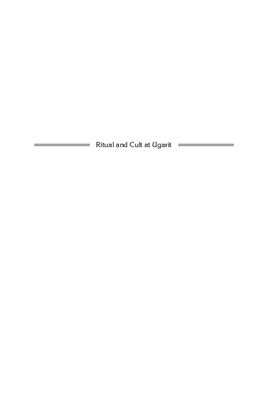Pardee D. Ritual and Cult at Ugarit. Atlanta, 2002. - 314 p. The
Ugaritic ritual texts provide the only extensive documentary data
for Late Bronze cultic practice in the greater Syro-Palestinian
region. These texts, in a West-Semitic language that belongs to the
same family as Hebrew and Aramaic, reflect the actual practice of a
sacrificial cult in the city of Ugarit in the late twelfth–early
eleventh centuries B.C.E. Based on new collations of the tablets,
these texts and translations provide ready access to this direct
witness to the form taken by one of the predecessors of the
biblical sacrificial cult. In addition to the narrowly ritual
texts, which were composed in prose and in a very laconic form of
expression, a number of poetic texts are presented that reveal the
ideological link that existed between cultic practice and the
concept of royalty. While the prose ritual texts document a regular
system of offerings to the great deities of the pantheon, related
directly to the lunar cycle and less directly to the solar year,
some of the poetic texts reveal the desire on the part of the kings
of Ugarit to maintain ties with their departed ancestors. The kings
saw their effective power as consisting of a continuum from the
royal ancestors through to the reigning king and the passage of
this power as being effected by ritual practice. More mundane
conces were also addressed ritually, such as protecting horses or
other equids from snakebite, finding a cure for a sick child, or
defending people from attack by sorcerers. The practice of
divination at Ugarit is documented by other texts, both in the form
of "manuals, " collections of omens from past practice, and in the
form of accounts of real-world consultations of a divinatory priest
by someone seeking guidance.
Pardee D. Ritual and Cult at Ugarit
- формат pdf
- размер 1.08 МБ
- добавлен 20 сентября 2010 г.

Смотрите также
Del Olmo Lete G., Sanmart?n J. A Dictionary of the Ugaritic Language in the Alphabetic Tradition
- формат pdf
- размер 44.51 МБ
- добавлен 30 декабря 2010 г.
Brill, 2002. - 1024 p. Since the mid-twentieth century Ugaritic studies has witnessed an enormous increase of edited texts. Naturally, but scattered in numerous publications, at the same time huge advances have been made in epigraphy, grammatical analysis and lexicography. The current dictionary is an updated and considerably augmented English edition – prepared by W.G.E. Watson – of G. Del Olmo Lete and J. Sanmart?n, Diccionario de la lengua u...
Halayqa I.K.H. A comparative lexicon of Ugaritic and Canaanite
- формат pdf
- размер 21.69 МБ
- добавлен 09 августа 2011 г.
Ugarit-Verlag, 2008. - 549 p. I. K. H. Halayqa investigates lexical correspondences of Ugaritic and Canaanite: "Ugaritic was a spoken and written language in an area adjacent to various Canaanite dialects, such as the language of the El-Amarna letters from the city states in Syria, Lebanon and Palestine and Phoenician in Lebanon. Ugaritic was still a spoken language in the El-Amarna period, to which Old Canaanite belongs. Therefore the generic r...
Schniedewind W.M., Hunt J.H. A primer on Ugaritic: language, culture, and literature
- формат pdf
- размер 2.03 МБ
- добавлен 04 сентября 2010 г.
Schniedewind W.M. , Hunt J.H. A primer on Ugaritic: language, culture, and literature. Cambridge: Cambridge University Press, 2007. - 226 p. A Primer on Ugaritic is an introduction to the language of the ancient city of Ugarit, a city that flourished in the second millennium BCE on the Lebanese coast, placed in the context of the culture, literature, and religion of this ancient Semitic culture. The Ugaritic language and literature was a precurso...
Sivan D. A grammar of the Ugaritic language
- формат pdf
- размер 14.42 МБ
- добавлен 07 сентября 2010 г.
Sivan D. A grammar of the Ugaritic language. Leiden, 2001. - xxii + 330 p. Ugaritic, discovered in 1929, is a North-West Semitic language, documented on clay tablets (about 1250 texts) and dated from the period between the 14th and the 12th centuries B.C.E. The documents are of various types: literary, administrative, lexicological. Numerous Ugaritic tablets contain portions of a poetic cycle pertaining to the Ugaritic pantheon. Another part, the...
